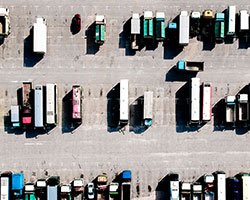<< Research Projects Overview << Year Two Projects Overview
Truck Parking Study: Unveiling the Parking Space Density and Truck Volume Relationship – Phase II

Associate Professor, Associate Professor
Texas A&M University
bwang@civil.tamu.edu
Professor, ZACHRY Department of Civil Engineering
Texas A&M University
yzhang@civil.tamu.edu
Proposal Summary and Objectives
The truck parking issues have caught wide attention as a national concern for many years. There are several reasons for the attention. One is that truck driving and on duty hours are regulated by the federal law for the sake of traffic safety. Truckers cannot drive for more than 8 straight hours within any consecutive 24 hours of time. Truckers, especially those for inter-city travel, must find a rest area with an available spot when the driving hours reaches its federally enforced limit. Truck volumes fluctuate with time of year and time of day driven by economic activities. The intuitive observation is that a higher volume demands more parking space statistically. Due to unavailability of truck parking space at locations it is needed, truckers are often found parking illegally on highway ramps or other unsafe spots. Or some truckers are caught driving beyond the hours limit, which significantly contribute to the highway fatal rate. As a result, almost every state has conducted truck parking studies in an effort to address truck parking issues. The objective of this study is to continue on the success of Phase I of this effort by continuing to study the relation between truck volume and parking space density in a simulation environment as phase I. The truck space availability issue is essentially one between volume and density subject to boundary conditions. In phase I, the team developed computer simulation program to numerically show the relationship between volume, driving behavior and parking capacity need, which allows to illustrate the inherent relationship between behavior, truck volume and parking capacity needs. In addition, Phase I has also led to a literature review that surprisingly identifies cases in telecommunication area which model the relationship between cell phone travelers volume and ground station service capacity and spacing, also along a highway. However, that study is inherently different from this truck parking problem, although it sheds light to the problem. Our goal in Phase II is to build on the literature reviewed and also utilize the simulation tool developed in Phase I to analytically derive the inherent analytical relationship between truck volume, driving behavior and truck parking capacity need in a hope that policy makers may use to examine adequacy of truck parking space within their jurisdiction areas.
Funding Amount: $60,000
Status: Complete
Duration: Dec. 13, 2018 - Dec. 13, 2019